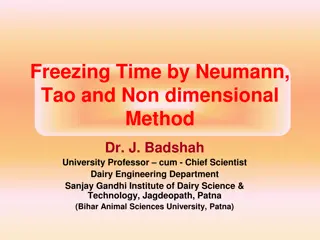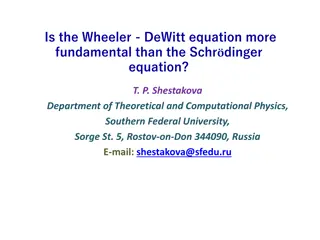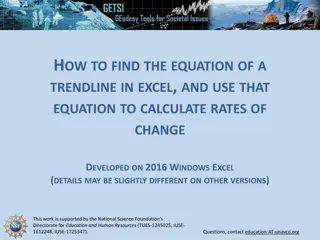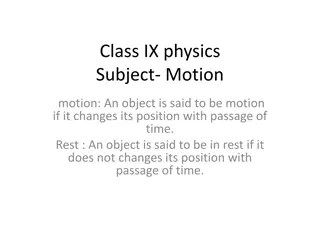Understanding Bernoulli's Equation in Fluid Mechanics
Bernoulli's equation, a fundamental principle in fluid dynamics, relates pressure, kinetic energy, and potential energy of a fluid flowing in a pipe. Through examples and explanations, explore how this equation can be used to calculate velocity, pressure differences, and forces in various scenarios
1 views • 12 slides
Understanding Projectile Motion: Characteristics, Examples, and Formulas
Projectile motion involves the motion of objects under the influence of gravity, with both vertical and horizontal components. This type of motion is seen in activities such as throwing a ball, kicking a football, or dropping objects. The motion is described by specific formulas, including calculati
1 views • 19 slides
Understanding Newton's First Law of Inertia
Newton's first law of inertia states that objects remain at rest or in uniform motion unless acted upon by an external force. This law, also known as the law of inertia, explains how objects tend to maintain their current state of motion unless influenced by an external force. Objects at rest stay a
0 views • 14 slides
Understanding Waveguiding Systems and Helmholtz Equation in Microwave Engineering
Waveguiding systems are essential in confining and channeling electromagnetic energy, with examples including rectangular and circular waveguides. The general notation for waveguiding systems involves wave propagation and transverse components. The Helmholtz Equation is a key concept in analyzing el
2 views • 50 slides
Understanding Motion: Frames of Reference and Relative Motion
Motion is defined as a change in position over time. To describe motion accurately, one needs to understand frames of reference and relative motion. Frames of reference are systems of objects used to determine if something is in motion, while relative motion involves movement in relation to a refere
3 views • 14 slides
Understanding Thermodynamics and Fluid Mechanics Fundamentals for Efficiency
Explore key concepts in thermodynamics and fluid mechanics such as the equation of continuity, the first law of thermodynamics, the momentum equation, Euler's equation, and more. Learn about efficiency, internal energy, and the laws governing energy transfer in various systems. Delve into topics lik
2 views • 12 slides
Understanding Motion Under Constant Acceleration
Constant acceleration refers to motion where the speed increases by the same amount each second. It is exemplified in scenarios like free fall due to gravity, where objects experience a consistent acceleration of approximately 10 meters per second squared. This type of motion plays a significant rol
0 views • 11 slides
Understanding Motion: Concepts and Definitions in Physics
Motion in physics is defined as the change in position of an object over time. It involves concepts like rest, motion, distance, displacement, rate of motion, and types of motion. Rest and motion are relative to a reference point, while distance and displacement differ in their scalar and vector nat
2 views • 25 slides
Understanding the Hammett Equation in Chemical Reactions
The Hammett equation explores how substituents influence the dissociation of benzoic acid, affecting its acidity. By quantifying this influence through a linear free energy relationship, the equation helps predict the impact of substituents on different processes. Through parameter definitions and m
0 views • 9 slides
Introduction to Dynamic Structural Equation Modeling for Intensive Longitudinal Data
Dynamic Structural Equation Modeling (DSEM) is a powerful analytical tool used to analyze intensive longitudinal data, combining multilevel modeling, time series modeling, structural equation modeling, and time-varying effects modeling. By modeling correlations and changes over time at both individu
0 views • 22 slides
Understanding Orbital Mechanics: Kepler's Laws, Center of Mass, and Equation of Motion
Exploring the fundamental concepts in orbital mechanics including Kepler's Laws, center of mass calculations, and equations of motion for celestial bodies. Topics covered include the laws of planetary motion, center of mass reference frame, and the concept of reduced mass in celestial mechanics.
0 views • 15 slides
Understanding Separation Columns in Chemical Engineering
Explore the world of separation columns including distillation, absorption, and extraction, along with empirical correlations, minimum number of stages, Fenske equation, Underwood equation, Kirkbride equation, examples, and solutions presented by Dr. Kh. Nasrifar from the Department of Chemical and
5 views • 15 slides
Comprehensive Overview of Freezing Time Methods in Dairy Engineering
Neumann, Tao, and Non-Dimensional methods are key approaches for determining freezing times in unsteady state heat transfer processes in dairy engineering. The Neumann Problem, Tao Solutions, and Cleland and Earle Non-Dimensional Equation offer distinct equations and models to calculate freezing tim
1 views • 8 slides
Understanding Linear and Rotational Motion in Physics
Explore the concepts of linear momentum, center of mass, rotational motion, and angular displacement in physics. Learn how to determine the center of mass of objects, analyze motion of particle groups, and understand the conservation of momentum in systems under external forces. Delve into the funda
0 views • 18 slides
Understanding Circular Motion in Physics
Circular motion involves objects moving in a circular path at a constant speed, experiencing acceleration and centripetal force. This motion is characterized by angular speed, centripetal acceleration, and the necessary centripetal force. The concept of uniform circular motion and angular displaceme
3 views • 38 slides
Understanding Newton's First Law of Motion
Exploring the foundational concepts of motion and forces, this content delves into Isaac Newton's First Law of Motion. Describing how objects behave when the net force acting on them is zero, the law highlights the significance of inertia and balanced forces in determining an object's state of rest
0 views • 9 slides
Introduction to Quantum Mechanics: Energy Levels and Schrödinger Equation
Quantum mechanics reveals that all systems possess discrete energy levels, determined by solving the Schrödinger equation where the Hamiltonian operator represents total energy. In a particle-in-a-box scenario, potential energy is infinite outside the box. The Schrödinger equation simplifies to a
0 views • 12 slides
Fundamental Comparison: Wheeler-DeWitt vs. Schrödinger Equation
The debate on whether the Wheeler-DeWitt equation is more fundamental than the Schrödinger equation in quantum gravity remains inconclusive. While the Wheeler-DeWitt equation presents an elegant formulation, the Schrödinger equation is essential in specific cases. The issue of time and coordinate
0 views • 6 slides
Understanding Vertical Motion and Gravity in Kinematics
Explore the principles of vertical motion and gravity in kinematics through scenarios involving throwing objects, free-fall motion, and calculating heights. Learn how to model vertical motion with acceleration due to gravity, find maximum heights of thrown objects, solve extended problems, and under
2 views • 12 slides
Understanding Open Channel Flow and Mannings Equation
This review covers hydraulic devices such as orifices, weirs, sluice gates, siphons, and outlets for detention structures. It focuses on open channel flow, including uniform flow and varied flow, and explains how to use Mannings equation for calculations related to water depth, flow area, and veloci
1 views • 43 slides
Understanding Newton's Laws of Motion
Explore the fundamental concepts of Newton's Laws of Motion, including net forces, combining forces, balanced versus unbalanced forces, and the concept of inertia. Learn how these principles explain the behavior of objects in motion and at rest, and discover the impact of mass on an object's resista
0 views • 17 slides
Exploring Membrane Potential Densities and the Fokker-Planck Equation in Neural Networks
Delve into the concepts of membrane potential densities and the Fokker-Planck Equation in neural networks, covering topics such as integrate-and-fire with stochastic spike arrival, continuity equation for membrane potential density, jump and drift flux, and the intriguing Fokker-Planck Equation.
0 views • 29 slides
Understanding Joint Motion: Osteokinematic and Arthrokinematic Movements
Joint motion involves osteokinematic movements, which are under voluntary control and include flexion, extension, and more. End-feel sensations like bony, capsular, and springy block indicate different joint conditions. Arthrokinematic motion refers to how joint surfaces move during osteokinematic m
0 views • 17 slides
Leapfrog Scheme for Advection Equation
The provided images illustrate the Leapfrog scheme applied to an advection equation, focusing on the center method in time and space. The stability of the method is analyzed with assumptions regarding the behavior of the solution. Through the exploration of Courant numbers and CFL conditions, the st
0 views • 25 slides
Understanding Newton's Laws of Motion
Newton's Laws of Motion explain the relationship between forces and motion. The first law states that an object in motion stays in motion unless acted upon by a net force, while the second law describes how force is related to an object's mass and acceleration. The third law states that for every ac
0 views • 21 slides
Excel Tutorial: Finding Trendline Equation and Calculating Rates of Change
Learn how to find the equation of a trendline in Excel and use it to calculate rates of change. This step-by-step guide includes importing data, adding a trendline, displaying the equation, and interpreting it for analysis. Make the most of Excel's features for data analysis.
0 views • 11 slides
Circular Motion Revision for AQA Syllabus
Circular motion involves experiencing a centripetal force leading to acceleration toward the center of a circle. Understanding angular speed, centripetal force, and the equations associated with circular motion are crucial for a comprehensive comprehension of this topic. An example problem and Newto
0 views • 26 slides
Linearized Boltzmann Equation in Statistical Mechanics
This lecture delves into the linearized Boltzmann equation and its applications in studying transport coefficients. The content covers the systematic approximation of transport coefficients, impact parameters of collisions, and the detailed solution for a dilute gas system. It explores the notation
0 views • 25 slides
Understanding Newton's Laws of Motion
Newton's Laws of Motion describe how objects behave in response to external forces. The first law states that objects in motion remain in motion unless acted upon by a force, while objects at rest stay at rest. The second law relates force, mass, and acceleration, showing how they are interconnected
0 views • 11 slides
Understanding Motion and Newton's Laws
Explore the concepts of motion, distance, speed, and velocity as they relate to Newton's Laws of Motion. Learn about measuring motion, calculating speed, graphing motion on distance-time graphs, and understanding velocity. Discover how motion is constant and how relative motion is used. Practice cal
0 views • 36 slides
Understanding Motion and Newton's Laws
Motion is the constant change in position of objects, measured by distance and displacement. Speed is the rate of motion, while velocity includes direction. Graphing motion helps visualize speed changes over time. Newton's Laws explain the behavior of objects in motion.
0 views • 38 slides
Understanding Dependent and Relative Motion in Dynamics
Dependent Motion and Relative Motion are fundamental concepts in Dynamics, providing the foundation for future analysis. Dependent Motion involves constraints like ropes or cables, while Relative Motion considers observers in motion. Dynamics involves applying a limited set of equations in diverse w
0 views • 18 slides
Understanding Motion: Types and Physics
Motion refers to a body changing position with respect to its surroundings. Different types of motion include linear, rotatory, and oscillatory motion. The physics relating to motion is called Mechanics, which comprises Dynamics and Kinematics. Scalars and vectors play a crucial role in describing t
0 views • 8 slides
Understanding Transverse Wave Motion in Physics
Explore the concepts of transverse wave motion, velocities in wave motion, group velocity, dispersion, and the transverse wave equation on a string. Visual examples and explanations enhance the understanding of these fundamental principles in physics.
1 views • 30 slides
Analysis and Comparison of Wave Equation Prediction for Propagating Waves
Initial analysis and comparison of the wave equation and asymptotic prediction of a receiver experiment at depth for one-way propagating waves. The study examines the amplitude and information derived from a wave equation migration algorithm and its asymptotic form. The focus is on the prediction of
0 views • 23 slides
Understanding Motion Along a Straight Line
Exploring the concepts of speed, acceleration, velocity, displacement, and distance in one-dimensional motion. Topics include average and instantaneous velocity, equation of motion, graphical analysis, position measurement, and the differences between distance and displacement. Dive into average spe
0 views • 47 slides
Understanding Motion Perception in Computational Vision
In computational vision, the concept of motion opponency plays a crucial role in how the brain processes left and right motion inputs. By examining psychophysical results and the construction of motion opponent energy filters, we explore how the brain handles motion information. Additionally, the Ve
0 views • 23 slides
Understanding Motion in Physics: Definitions and Examples
An object is said to be in motion if it changes position with time, while rest implies no change. Learn about types of motion such as linear and circular, as well as vibratory motion and reference points. Explore how objects can be in motion relative to one reference point while at rest relative to
0 views • 4 slides
Understanding Newton's Second Law of Motion
Exploring Newton's Second Law of Motion which states that an unbalanced force acting on a particle causes acceleration proportional to the force. The law is expressed as F=ma, highlighting the relationship between force, mass, and acceleration. Additionally, the concept of gravitational attraction a
0 views • 15 slides
Evolution of Motion Theories: Aristotle to Einstein
Explore the progression of motion theories from Aristotle's belief in a force for motion to Galileo's discoveries on gravity, Newton's laws of motion, and Einstein's theories of relativity and quantum mechanics. Discover how our understanding of motion has evolved over the centuries, shaping the way
0 views • 20 slides







































